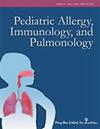Racial and Ethnic Differences of Influenza-Associated Pediatric Hospitalizations and Deaths, 2008-2017.
IF 0.8
4区 医学
Q4 ALLERGY
引用次数: 1
Abstract
Background: Influenza is one of the most common causes of acute respiratory infections in children; its complications are a leading cause of morbidity and mortality. There is a paucity of pediatric data on influenza disparities among racial/ethnic minorities. Our study assesses if there are racial/ethnic differences in hospitalizations and mortality in children infected with influenza. Methods: This was a retrospective cohort study using the National Inpatient Sample (NIS) from January 1, 2008 to December 31, 2017. We included children 18 years and younger hospitalized with a primary or secondary diagnosis of influenza or its subtypes. We generated adjusted odds ratios (aORs) and 95% confidence intervals (CIs) to evaluate the associations between patient characteristics and influenza hospitalizations and influenza-related mortality. Results: There were 226,535 (0.04%) influenza-associated hospitalizations. When compared with non-Hispanic (NH) White children, minority children were more likely to be hospitalized with an influenza diagnosis [Hispanics (aOR = 1.25; 95% CI, 1.17 to 1.33), NH-Blacks (aOR = 1.21, 95% CI, 1.17 to 1.33) and NH-Others group (aOR = 1.11; 95% CI, 1.04 to 1.19)]. There was no racial/ethnic difference in mortality. Conclusions: Minority children experienced a higher likelihood of influenza-associated hospitalizations but not mortality. Further research is needed to reduce the racial/ethnic disparities of influenza's impact.2008-2017年流感相关儿童住院和死亡的种族差异
背景:流感是儿童急性呼吸道感染的最常见原因之一;其并发症是发病率和死亡率的主要原因。关于种族/少数民族之间流感差异的儿科数据缺乏。我们的研究评估了流感感染儿童的住院率和死亡率是否存在种族/民族差异。方法:采用2008年1月1日至2017年12月31日的国家住院患者样本(NIS)进行回顾性队列研究。我们纳入了原发性或继发性流感或其亚型诊断的18岁及以下住院儿童。我们采用校正优势比(aORs)和95%置信区间(CIs)来评估患者特征与流感住院和流感相关死亡率之间的关联。结果:有226,535例(0.04%)流感相关住院。与非西班牙裔(NH)白人儿童相比,少数族裔儿童更有可能因流感诊断住院[西班牙裔(aOR = 1.25;95% CI, 1.17 ~ 1.33), NH-Blacks组(aOR = 1.21, 95% CI, 1.17 ~ 1.33)和NH-Others组(aOR = 1.11;95% CI, 1.04 ~ 1.19)。死亡率没有种族/民族差异。结论:少数民族儿童流感相关住院的可能性较高,但死亡率不高。需要进一步研究以减少流感影响的种族/族裔差异。
本文章由计算机程序翻译,如有差异,请以英文原文为准。
求助全文
约1分钟内获得全文
求助全文
来源期刊

Pediatric Allergy Immunology and Pulmonology
ALLERGY-IMMUNOLOGY
CiteScore
2.00
自引率
0.00%
发文量
23
审稿时长
>12 weeks
期刊介绍:
Pediatric Allergy, Immunology, and Pulmonology is a peer-reviewed journal designed to promote understanding and advance the treatment of respiratory, allergic, and immunologic diseases in children. The Journal delivers original translational, clinical, and epidemiologic research on the most common chronic illnesses of children—asthma and allergies—as well as many less common and rare diseases. It emphasizes the developmental implications of the morphological, physiological, pharmacological, and sociological components of these problems, as well as the impact of disease processes on families.
Pediatric Allergy, Immunology, and Pulmonology coverage includes:
-Functional and genetic immune deficiencies-
Interstitial lung diseases-
Both common and rare respiratory, allergic, and immunologic diseases-
Patient care-
Patient education research-
Public health policy-
International health studies
 求助内容:
求助内容: 应助结果提醒方式:
应助结果提醒方式:


